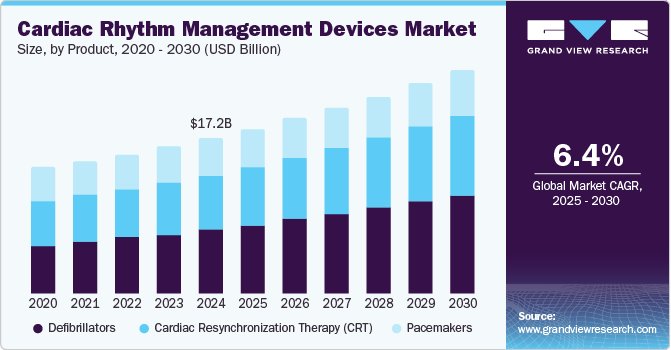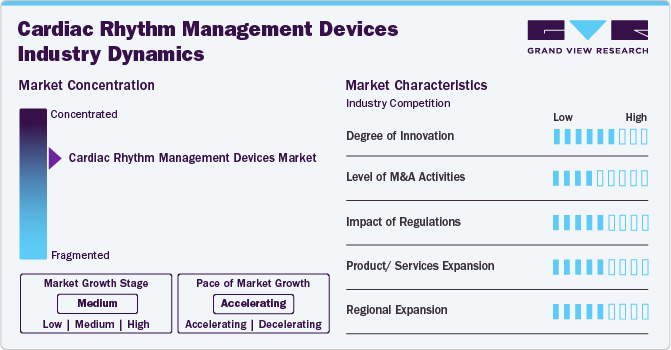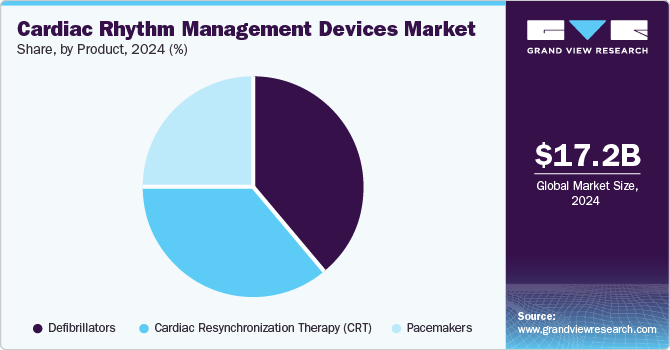
Cardiac Rhythm Management Devices Market Size, Share & Trends Analysis Report By Products (Pacemakers (Implantable, External), Defibrillators, Cardiac Resynchronization Therapy), By Region, And Segment Forecasts, 2025 - 2030
- Report ID: GVR-2-68038-315-7
- Number of Report Pages: 150
- Format: PDF, Horizon Databook
- Historical Range: 2018 - 2024
- Forecast Period: 2025 - 2030
- Industry: Healthcare
Market Size & Trends
The global cardiac rhythm management devices market size was estimated at USD 17.17 billion in 2024 and is projected to grow at a CAGR of 6.4% from 2025 to 2030. Growing prevalence of various cardiovascular diseases, such as arrhythmia and atrial fibrillation, among others. According to the Centers for Disease Control and Prevention (CDC), around 12.1 million people in the U.S. are expected to suffer from atrial fibrillation (AFib) by 2030. Furthermore, various technological advancements related to the market such as integration of AI, remote monitoring, and wearable technology, are also anticipated to fuel the market growth.

The COVID-19 pandemic has impacted all industries, including the market. Market players have experienced huge losses in their cardiac rhythm management segments due to the postponement of cardiovascular procedures during the pandemic outbreak. For instance, Medtronic experienced a 12.0% decrease in its cardiac rhythm management devices segment in 2020 compared to 2019. The decline was majorly experienced in ICDs, CRT-Ds, and pacemakers’ segment, among others. In 2021, Medtronic will recover in terms of its annual revenue and the cardiac rhythm & heart failure segment’s revenue. The company experienced a rise of 4.16% in its total revenue from 2020 to 2021. Similar trends are noticed in the financial results of other market players. Hence, the market was initially negatively influenced by the pandemic. However, it has started to recover in 2021.
Physical inactivity is a major public health concern as it is the second most common death-causative agent in the U.S. Physical inactivity leads to morbidity and the development of chronic conditions such as cardiac disorders and diabetes. As per WHO, physical inactivity or a sedentary lifestyle results in around 2 million deaths per year. In addition, it has been estimated that around 60% to 85% of the population in both developed and developing countries leads a sedentary lifestyle. This is further anticipated to increase the demand forcardiac rhythm management devices over the forecast period.
Favorable reimbursement policies have led to higher adoption of medical devices by patients in countries like Canada, the U.S., and the UK, thereby increasing market penetration. Furthermore, increasing government efforts and the adoption of new CRM technologies are expected to boost growth over the forecast period. For instance, regulations regarding the use of external defibrillators in public places. In California, the New Laws of 2018 mandate placing an Automated External Defibrillator (AED) at various locations, including schools and public swimming pools.
Owing to the increasing life expectancy and availability of advanced technologies, the adoption of CRM devices has increased in the past few years. Heart disease is the major cause of death in recent years. According to estimates from the World Health Organization (WHO), approximately 17.9 million deaths occur annually due to cardiovascular diseases (CVDs). Often referred to as the 'silent epidemic,' these diseases manifest symptoms slowly. Moreover, they are considered among the costliest health conditions to manage. CRM devices manage and monitor cardiac issues and have applications in repairing, restoring, and healing cardiac activities. These associated benefits are expected to boost the adoption over the forecast period.
Market Concentration & Characteristics
The market demonstrates a high degree of innovation, characterized by continuous advancements in device technology, including pacemakers and implantable cardioverter-defibrillators (ICDs). Companies are continuously enhancing the functionality, usability, and efficiency of cardiac rhythm management devices.
Market players such as Boston Scientific Corporation, Medtronic plc, and Koninklijke Philips N.V. are involved in merger and acquisition activities. Through M&A activity, these companies can expand their geographic reach and enter new territories. For instance, in January 2021,Boston Scientific Corporation acquired a stake in Preventice Solutions, a manufacturer of wearable heart monitors. With this acquisition, Boston Scientific Corporation aims to expand its product portfolio.

Regulations significantly impact the cardiac rhythm management devices market. Regulations ensure safety, efficacy, and adherence to standards, influencing product development and market entry.
Potential substitutes in the market include wearable health monitors and emerging non-invasive technologies, offering alternatives to traditional implantable devices and influencing patient preferences in cardiovascular care.
Companies in the market are pursuing regional expansion strategies, establishing partnerships and distribution networks to capitalize on growing healthcare demands and market opportunities in key geographical areas.
Product Insights
The defibrillators segment held the largest share of over 44.9% in 2024. The dominance in the market is primarily due to the rising adoption of Subcutaneous Implantable Defibrillator (S-ICD) and Transvenous Implantable Cardioverter Defibrillator (T-ICD) across major regional markets, including the U.S., European countries, China, and India. These defibrillators fall under implantable cardioverter defibrillators (ICD) and external defibrillators. The external defibrillator segment is expected to experience the fastest growth rate during the forecasted period, largely driven by the increasing usage of these devices, particularly in public settings

The cardiac resynchronization therapy (CRT) segment is expected to show lucrative growth over the forecast period. The main factors driving this segment are the potential decrease in blood transfusions, lower risk of infection, and shorter hospital stays. Medical experts are increasingly advocating for minimally invasive surgical procedures for the installation of CRT-Pacemakers to address instances of bradycardia and cardiac arrest. This shift towards less intrusive methods for CRT-P implantation is predicted to stimulate sales growth during the forecast period.
Regional Insights
North America cardiac rhythm management devices market dominated the with a share of 45.9% in 2024. This phenomenon can be attributed to several factors, including the robust healthcare infrastructure already in place, the growing elderly population, the swift acceptance of advanced technology-driven products like those offering extended battery life, biocompatibility, miniaturization, and leadless designs, and the escalating number of regulatory approvals. Many organizations are actively developing new devices leveraging existing pacemaker and Implantable Cardioverter Defibrillator (ICD) technologies.

U.S. Cardiac Rhythm Management Devices Market Trends
The U.S. cardiac rhythm management devices market accounted for the largest market share in North America in 2024. The U.S. has a well-established healthcare infrastructure with a high prevalence of cardiovascular diseases, contributing to a robust demand for cardiac rhythm management devices. Moreover, major market players, including prominent medical device companies headquartered in the U.S., further strengthen the country's leadership.
Europe Cardiac Rhythm Management Devices Market Trends
The launch of new products in Europe cardiac rhythm management devices market is expected to drive the market due to the increasing prevalence of cardiovascular diseases and the rise in the geriatric population. These new devices offer improved accuracy & efficiency in monitoring and treating cardiac rhythm disorders. In addition, technological advancements and increasing investments in R&D by key players in the industry are expected to drive market growth further.
The cardiac rhythm management devices market in the UK has been growing in recent years. This can be attributed to the increasing prevalence of cardiac disorders, such as atrial fibrillation and congenital heart defects, which require the use of EP devices for diagnosis & treatment. As per the British Heart Foundation, in 2022, a total number of 174,884 people died due to CVD in the UK.
The CRM devices market in Germany has been driven by technological advancements, which have led to the development of more effective & safe devices. Technological advancements have enabled the development of more advanced devices that offer better monitoring, diagnostic capabilities, and treatment options for patients with cardiac conditions.
Asia Pacific Cardiac Rhythm Management Devices Market Trends
The Asia Pacific cardiac rhythm management devices market is expected to grow fastest during the forecast period. The increase in research and development investments by international bodies such as the China Cardiovascular Association and the American College of Cardiology collaborating to advance cardiac care technologies is one of the reasons behind this. Even though developed Asian economies are still trailing OECD nations in combating the causes of Cardiovascular Diseases (CVDs), including tobacco consumption, the rise in awareness initiatives, like Japan's smoke-free policy for the 2020 Olympic Games, is anticipated to spur growth.
China cardiac rhythm management devices market accounted for the largest market share in the Asia Pacific region in 2024. China has experienced rapid economic growth, resulting in an expanding healthcare sector with increased investments in advanced medical technologies, including cardiac rhythm management devices. The country's large aging population contributes to a higher incidence of cardiovascular diseases, driving the demand for such devices.
Australia Cardiac Rhythm Management Devices Market Cardiovascular diseases, such as AF, Ventricular Tachycardia (VT), and other arrhythmias, are prevalent in Australia. These conditions can lead to adverse health outcomes, including strokes and sudden cardiac death. According to the Australian Institute of Health and Welfare, CVD was the underlying cause of 42,700 deaths (25% of all deaths) in 2021. As a result, there is a growing demand for EP devices to diagnose and manage these cardiac arrhythmias, driving the Australia cardiac rhythm management devices market.
Latin America Cardiac Rhythm Management Devices Market Trends
The CRM market in Latin America is expected to witness significant growth over the forecast period, driven by the growing awareness about cardiac arrest & increasing regulatory frameworks to support the availability of AEDs in public & private places. According to the American Heart Association, Inc., more Latin American countries are developing supportive regulatory frameworks to increase the availability of AEDs in high-traffic locations.
Middle East & Africa Cardiac Rhythm Management Devices Market Trends
The CRM Devices market in the MEA is growing significantly due to the rising prevalence of CVDs and the increasing adoption of advanced medical technologies in the region. The CRM devices market includes pacemakers, ICDs, CRT devices, and other monitoring & diagnostic devices.
Key Cardiac Rhythm Management Devices Company Insights
Leading players in the cardiac rhythm management market such as Boston Scientific Corporation, Medtronic and Abbott have strategically employed innovative approaches, including mergers and acquisitions, market penetration initiatives, partnerships, and distribution agreements. These strategies aim to enhance their revenue streams by leveraging collaborative efforts, expanding market reach, and fostering synergies within the dynamic landscape of cardiac rhythm management. For instance, in July 2020, Abbott received the U.S. Food and Drug Administration (FDA) clearance for its Gallant ICD and CRT-D devices, enabling the company to market the device in the U.S. while expanding its portfolio.
Emerging market entrants such as Progetti Srl and, LivaNova Plc are directing their efforts toward broadening their market presence, creating inventive technologies, and establishing strategic partnerships as part of their strategy to contend with established industry leaders.
Key Cardiac Rhythm Management Devices Companies:
The following are the leading companies in the cardiac rhythm management devices market. These companies collectively hold the largest market share and dictate industry trends.
- Physio-Control, Inc.
- Medtronic, plc
- ABBOTT
- Boston Scientific Corporation
- Schiller
- Koninklijke Philips N.V
- Biotronik
- Progetti Srl
- Zoll Medical Corporation
- LivaNova Plc
Recent Developments
-
In December 2023, Medtronic officially introduced its Penditure Left Atrial Appendage (LAA) Exclusion System in the U.S.
-
In October 2023, MicroPort CRM, has announced the introduction of the ULYS Implantable Cardioverter Defibrillator (ICDs) and the INVICTA defibrillation lead in the Japanese market, aiming to strengthen their product portfolio across the globe.
-
In October 2023, Boston Scientific has recently unveiled its latest innovation, the LUX-Dx II+ insertable cardiac monitor (ICM) system. This advanced system provides extended monitoring for arrhythmias linked to conditions such as atrial fibrillation (AFib), cryptogenic stroke, and syncope.
-
In April 2022, Abbott announced the approval of its Aveir single-chamber (VR) leadless pacemaker by the US FDA. This approval, aimed at treating patients suffering from slow heart rhythms in the US, signifies a substantial advancement in patient care, introducing novel features for both patients and their healthcare providers.
Cardiac Rhythm Management Devices Market Report Scope
|
Report Attribute |
Details |
|
Market size value in 2025 |
USD 18.2 billion |
|
Revenue forecast in 2030 |
USD 24.8 billion |
|
Growth rate |
CAGR of 6.4% from 2025 to 2030 |
|
Actual Data |
2018 - 2024 |
|
Forecast period |
2025 - 2030 |
|
Quantitative units |
Revenue in USD billion/million and CAGR from 2025 to 2030 |
|
Report coverage |
Revenue forecast, company ranking, competitive landscape, growth factors, and trends |
|
Segments covered |
Product, region |
|
Regional scope |
North America; Europe; Asia Pacific; Latin America; MEA |
|
Country scope |
U.S.; Canada; Mexico; UK; Germany; France; Italy; Spain; Denmark; Sweden; Norway; Japan; China; India; Australia; Thailand; South Korea; Brazil; Argentina; South Africa; Saudi Arabia; UAE; Kuwait |
|
Key companies profiled |
Physio-Control, Inc.; Medtronic, plc; ABBOTT; Boston Scientific Corporation; Schiller; Koninklijke Philips N.V; Biotronik; Progetti Srl; Zoll Medical Corporation; LivaNova Plc; |
|
Customization scope |
Free report customization (equivalent up to 8 analysts working days) with purchase. Addition or alteration to country, regional & segment scope. |
|
Pricing and purchase options |
Avail customized purchase options to meet your exact research needs. Explore purchase options |
Global Cardiac Rhythm Management Devices Market Report Segmentation
This report forecasts revenue growth at global, regional & country levels and provides an analysis of the industry trends in each of the sub-segments from 2018 to 2030. For this study, Grand View Research has segmented the global cardiac rhythm management devices market report based on product and region:

-
Product Outlook (Revenue, USD Million, 2018 - 2030)
-
Pacemakers
-
Implantable
-
External
-
-
Defibrillators
-
Implantable Cardioverter Defibrillators (ICD)
-
S-ICD
-
T-ICD
-
-
External Defibrillator
-
Manual External Defibrillator
-
Automatic External Defibrillator
-
Wearable Cardioverter Defibrillator
-
-
-
Cardiac Resynchronization Therapy (CRT)
-
CRT-Defibrillator
-
CRT-Pacemakers
-
-
-
Regional Outlook (Revenue, USD Million, 2018 - 2030)
-
North America
-
U.S.
-
Canada
-
Mexico
-
-
Europe
-
UK
-
Germany
-
France
-
Italy
-
Spain
-
Denmark
-
Sweden
-
Norway
-
-
Asia Pacific
-
Japan
-
China
-
India
-
South Korea
-
Australia
-
Thailand
-
-
Latin America
-
Brazil
-
Argentina
-
-
Middle East & Africa
-
South Africa
-
Saudi Arabia
-
UAE
-
Kuwait
-
-
Frequently Asked Questions About This Report
b. The global cardiac rhythm management devices market size was estimated at USD 17.17 billion in 2024 and is expected to reach USD 18.2 billion in 2025.
b. The global cardiac rhythm management devices market is expected to grow at a compound annual growth rate of 6.4% from 2025 to 2030 to reach USD 24.8 billion by 2030.
b. The defibrillator segment dominated the global CRM devices market and held the largest revenue share of 44.9% in 2024.
b. North America dominated the CRM devices market with a share of 45.9% in 2024. This is attributable increasing incidence of heart failures and arrhythmia and the availability of technologically advanced CRM devices.
b. Some key players operating in the CRM devices market include Medtronic, Jude Medical (Abbott); Boston Scientific Corporation; Koninklijke Philips N.V. Key; Physio-Control, Inc. (Stryker); Schiller; Zoll Medical Corporation; and BIOTRONIK.
We are committed towards customer satisfaction, and quality service.
"The quality of research they have done for us has been excellent."




